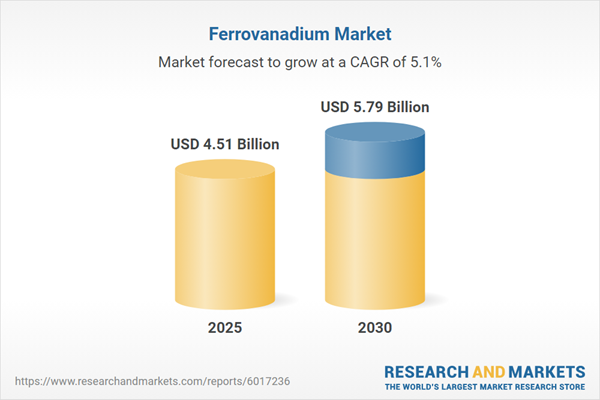Dublin, June 18, 2025 (GLOBE NEWSWIRE) -- The "Ferrovanadium Market by Application, Grade, Source, End Use Industry, Form - Global Forecast to 2030" has been added to ResearchAndMarkets.com's offering.
The ferrovanadium market is projected to grow from USD 4.51 billion in 2025 to USD 5.79 billion by 2030, driven by its integral role in enhancing high-performance steel. The market is evolving rapidly, driven by innovation in metallurgy and strategic alloy designs.

Transformative Shifts in Technology and Regulation
Technological advancements and regulatory changes are profoundly influencing the ferrovanadium market. The expansion of electric arc furnaces is altering consumption patterns, while producers focus on refining processes to deliver high-purity alloys essential for aerospace and battery systems. Concurrently, vanadium-based redox flow batteries are diversifying the application spectrum within the energy storage sector. Regulatory frameworks, emphasizing reduced emissions and onshore production, motivate steelmakers to pursue cleaner production pathways. Strategic partnerships and a circular economy approach are increasingly imperative to sustain competitiveness amidst these changes.
Tariff Dynamics and Their Impact on Trade
The introduction of tariffs on ferrovanadium imports to the United States in 2025 has significantly influenced the industry. This tariff adjustment has driven domestic producers to enhance capacity utilization, while international suppliers explore new trade agreements. As the U.S. market achieves greater price stability, albeit at elevated baselines, companies face challenges in alloy management strategies. Strategic procurement adjustments by downstream sectors are also notable, demonstrating how tariff policies can shape market dynamics. This focus on domestic supply chains may result in increased competitiveness and reduced dependency on imports. Decision-makers must navigate these complexities to maintain a balance between resilience and cost management.
Key Takeaways from This Report
- Regulatory developments and technological advancements are steering the market towards sustainable practices and innovative applications.
- Diverse applications across industries, including aerospace and automotive, highlight the varied demand drivers influencing this market.
- Regional dynamics and competitive strategies play a crucial role in shaping the market's supply, demand, and pricing structures.
- Understanding tariff impacts and fostering collaborations are essential for companies aiming to capture value and ensure operational agility.
Competitive Landscape and Strategic Imperatives
Competition in the ferrovanadium sector spans global mining conglomerates to specialized alloy producers. Vertical integration and strategic collaborations are key trends, with companies investing in low-carbon smelting technologies and forming alliances with battery developers. Quality assurance and traceability systems differentiate leading firms, enabling them to meet stringent material specifications. This competitive terrain necessitates resilience, innovation, and collaboration, ensuring robust supply chain management and energy-efficient production processes. By co-developing tailored solutions with end-users, particularly in the rapidly evolving battery and aerospace sectors, companies can secure higher margins and foster long-term customer loyalty.
Key Attributes
| Report Attribute | Details |
| No. of Pages | 196 |
| Forecast Period | 2025-2030 |
| Estimated Market Value (USD) in 2025 | $4.51 Billion |
| Forecasted Market Value (USD) by 2030 | $5.79 Billion |
| Compound Annual Growth Rate | 5.1% |
| Regions Covered | Global |
Key Topics Covered
1. Preface
1.1. Objectives of the Study
1.2. Market Segmentation & Coverage
1.3. Years Considered for the Study
1.4. Currency & Pricing
1.5. Language
1.6. Stakeholders
2. Research Methodology
3. Executive Summary
4. Market Overview
4.1. Introduction
4.2. Market Sizing & Forecasting
5. Market Dynamics
6. Market Insights
6.1. Porter's Five Forces Analysis
6.2. PESTLE Analysis
7. Cumulative Impact of United States Tariffs 2025
8. Ferrovanadium Market, by Application
8.1. Introduction
8.2. Chemical Industry
8.2.1. Catalyst
8.2.2. Redox Flow Battery
8.3. Foundry
8.3.1. Iron Foundry
8.3.2. Steel Foundry
8.4. Steel Production
8.4.1. Basic Oxygen Furnace
8.4.2. Electric Arc Furnace
8.4.3. Induction Furnace
9. Ferrovanadium Market, by Grade
9.1. Introduction
9.2. FeV50
9.3. FeV60
9.4. FeV80
10. Ferrovanadium Market, by Source
10.1. Introduction
10.2. Iron Ore
10.3. Steel Scrap
10.4. Vanadium Slag
11. Ferrovanadium Market, by End Use Industry
11.1. Introduction
11.2. Aerospace
11.3. Automotive
11.4. Construction
11.5. Pipeline
12. Ferrovanadium Market, by Form
12.1. Introduction
12.2. Lumps
12.3. Pellets
12.4. Powder
13. Americas Ferrovanadium Market
13.1. Introduction
13.2. United States
13.3. Canada
13.4. Mexico
13.5. Brazil
13.6. Argentina
14. Europe, Middle East & Africa Ferrovanadium Market
14.1. Introduction
14.2. United Kingdom
14.3. Germany
14.4. France
14.5. Russia
14.6. Italy
14.7. Spain
14.8. United Arab Emirates
14.9. Saudi Arabia
14.10. South Africa
14.11. Denmark
14.12. Netherlands
14.13. Qatar
14.14. Finland
14.15. Sweden
14.16. Nigeria
14.17. Egypt
14.18. Turkey
14.19. Israel
14.20. Norway
14.21. Poland
14.22. Switzerland
15. Asia-Pacific Ferrovanadium Market
15.1. Introduction
15.2. China
15.3. India
15.4. Japan
15.5. Australia
15.6. South Korea
15.7. Indonesia
15.8. Thailand
15.9. Philippines
15.10. Malaysia
15.11. Singapore
15.12. Vietnam
15.13. Taiwan
16. Competitive Landscape
16.1. Market Share Analysis, 2024
16.2. FPNV Positioning Matrix, 2024
16.3. Competitive Analysis
16.3.1. Glencore PLC
16.3.2. AMG Advanced Metallurgical Group N.V.
16.3.3. Tsingshan Holding Group Co., Ltd.
16.3.4. Qinghai Salt Lake Industry Co., Ltd.
16.3.5. Gansu Qiankun Vanadium & Titanium Co., Ltd.
16.3.6. Ferroglobe PLC
16.3.7. AccMet Materials, Inc.
16.3.8. Evraz PLC
16.3.9. Sichuan Chuangma Technology Co., Ltd.
16.3.10. voestalpine AG
For more information about this report visit https://www.researchandmarkets.com/r/ja81xf
About ResearchAndMarkets.com
ResearchAndMarkets.com is the world's leading source for international market research reports and market data. We provide you with the latest data on international and regional markets, key industries, the top companies, new products and the latest trends.
Attachment
